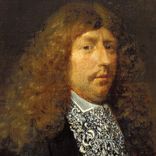
Gerard ter Borch
When it comes to the Golden Age of painting, we often think of painters from cities like Amsterdam, Leiden, Haarlem, and Delft, and occasionally Utrecht and Dordrecht. However, Gerard ter Borch proves that the art in the Dutch Republic thrived in other places as well. Gerard ter Borch primarily worked in the beautiful IJssel city of Deventer. The virtual museum of the fun part of art certainly appreciates the unique oeuvre of Gerard ter Borch!
The Life of Gerard ter Borch
Gerard ter Borch was born in 1617 in Zwolle. His father was also a painter, so Gerard was already familiar with the artistic environment and the elite of Zwolle at an early age. He learned many tricks of the trade at home, but to become a great painter in those days, you had to be in Haarlem. Therefore, Gerard ter Borch pursued his education in Haarlem and joined the Haarlem guild in 1635.
Unlike many of his fellow painters, Gerard ter Borch was not tied to Holland. This is evident from the numerous travels he undertook, sometimes spending extended periods abroad and establishing good contacts. He visited England, Italy, Spain, France, and the Southern Netherlands. These travels provided him with a great deal of inspiration. Later, he also worked in Münster, where he documented the signing of the Treaty of Münster in 1648.
Nevertheless, he eventually found his home along the IJssel, the river he had already become acquainted with in his youth. He married in Deventer and settled there. In Deventer, he remained active as a painter and was extraordinarily productive. He produced a wide variety of work of consistently high quality. Even though he did not live in "the Randstad" as we would describe it today, Gerard ter Borch was a renowned celebrity.
Gerard ter Borch passed away in Deventer in 1681, but he had requested to be buried in his birthplace, Zwolle, and that wish was honored.
Works by Gerard ter Borch
Ter Borch was an extremely versatile artist. He was celebrated for his astonishing realism; those who were portrayed by him could be sure that the portrait would be an exact likeness. This demonstrates his great technical skill; Ter Borch clearly mastered his craft to perfection.
Realism was not his only goal; in fact, many of his works emphasize symbolism, and Ter Borch could be quite mysterious. In his genre paintings, Ter Borch was narrative; he had something significant to convey to the viewer and included many clues in his paintings. However, Ter Borch was not intrusive; his paintings lend themselves to a personal and original interpretation.
Gerard ter Borch & the fun part of art
A painting that reads like a book, where everyone can have their thoughts, where an engaging and personal story arises – indeed, that is the fun part of art. For that, you are in the right place with Gerard ter Borch. In our virtual museum, Bas Zevenbergen tells you what he sees in Ter Borch's paintings and gives you the opportunity to discover even more for yourself.
